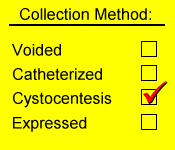|
Knowledge of the method of collection is often essential for full interpretation of
urinalysis results.
Collection of a voided sample is safest for the patient, but the urine is more likely
to contain contaminating bacteria, pollens, fibers, and other sorts of extraneous debris.
The timing of collection is somewhat dependent on the patient.
 Urine collected by catheterization is expected to be sterile, but
sometimes is contaminated by a degree of hemorrhage and/or mechanical exfoliation
of epithelial cells into the sample. Poor technique can introduce infection into the bladder.
Urine collected by catheterization is expected to be sterile, but
sometimes is contaminated by a degree of hemorrhage and/or mechanical exfoliation
of epithelial cells into the sample. Poor technique can introduce infection into the bladder.
Cystocentesis generally provides a sample free of microbial contamination, though
a minor degree of hemorrhage sometimes occurs. The method requires a relatively full bladder,
and entails some risk to the patient (penetration of other viscera, tearing of bladder, infection).
Manual compression of the bladder can be used to initiate urination in dogs and
cats. Application of steady gentle pressure should result in relaxation of urethral sphincters
and flow of urine, provided there is adequate urine in the bladder and a patent outflow tract.
Care must be taken to avoid excessive pressure which may injure the bladder or urethra,
causing hematuria and/or retrograde flow of potentially non-sterile bladder urine into the
ureters/kidneys.

|

| |
menu
|
next
|
Last Updated: Sunday, January 21, 1996
|